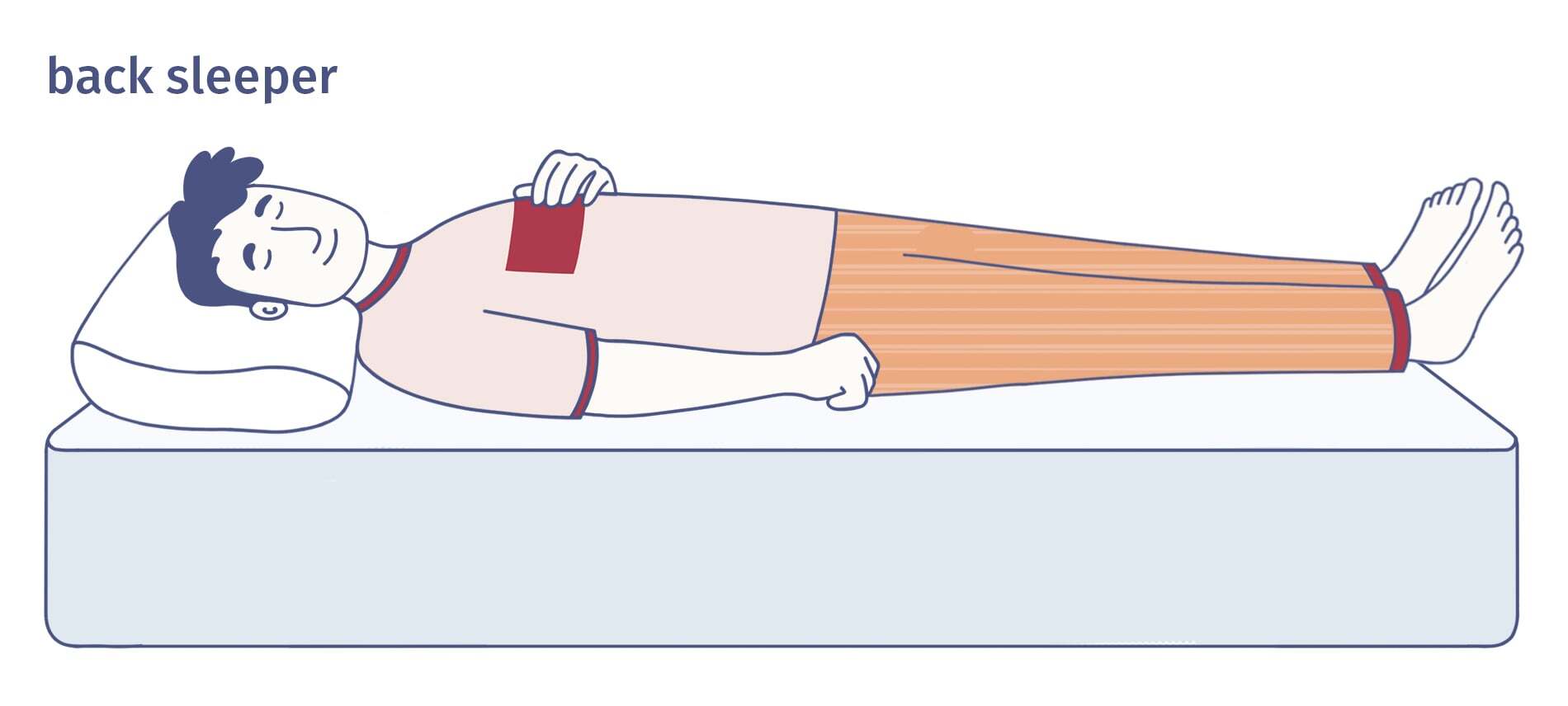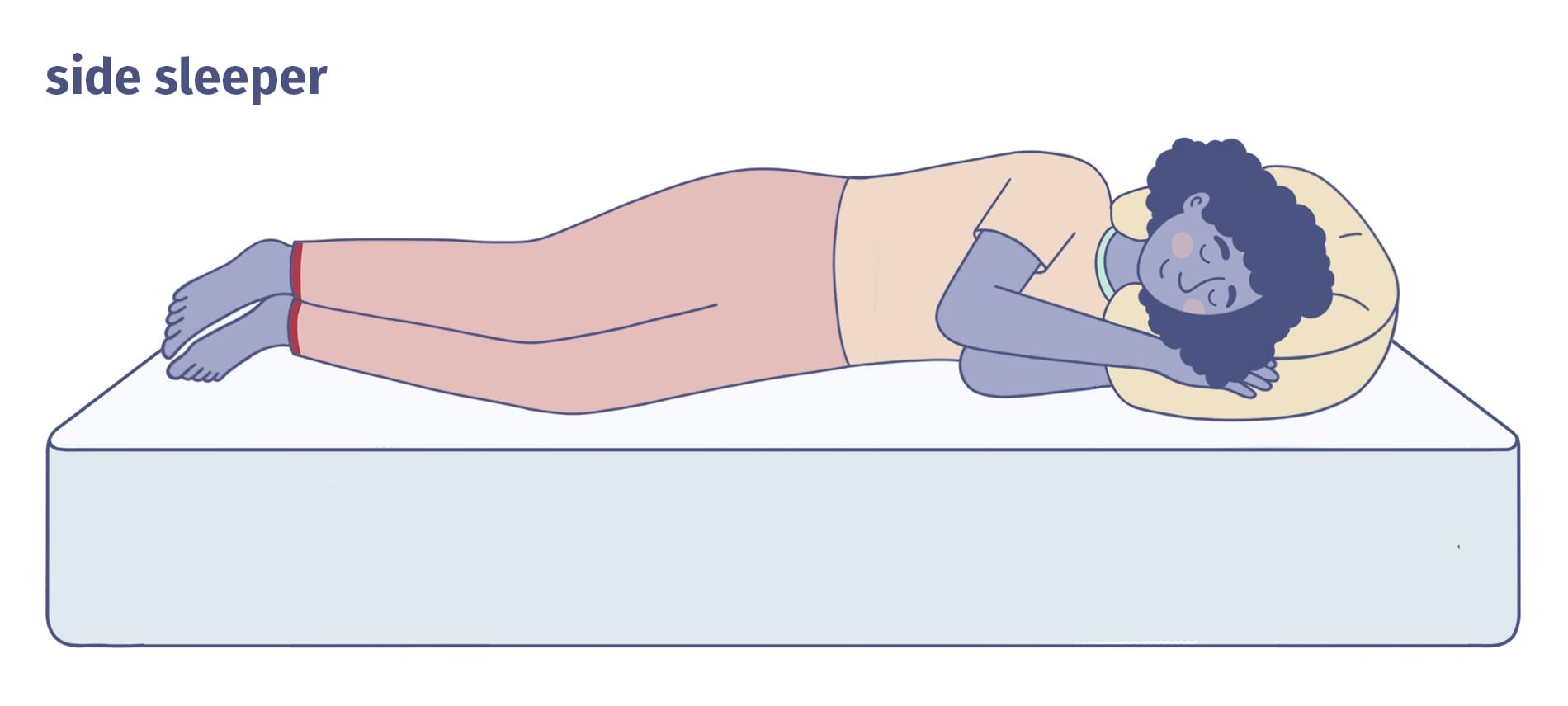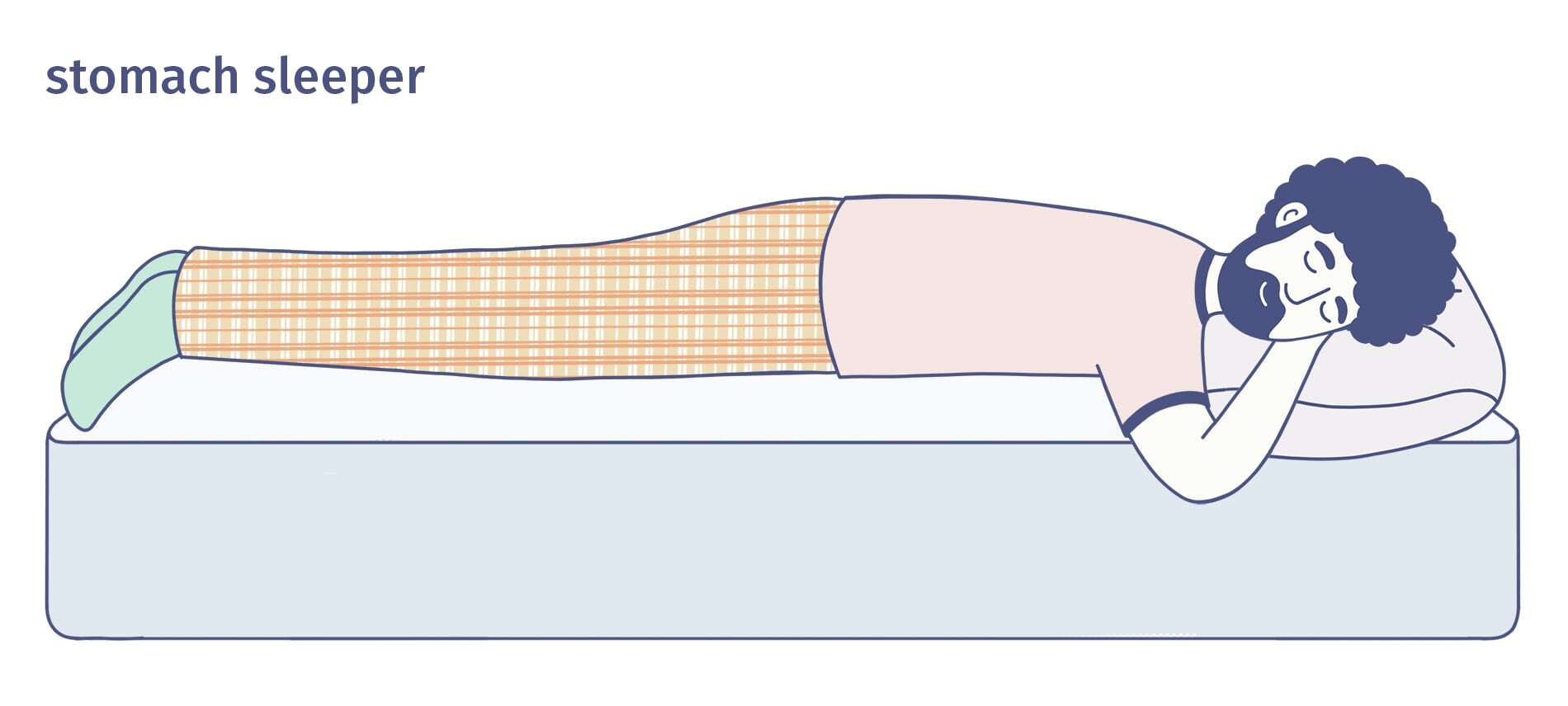Quick: How much time do you spend thinking about your sleep position? If you answered “not a whole lot,” you’re probably in good company. Sleep positions are hardly a staple of dinner table conversation. But maybe they should be.
Our chosen sleep position(s) can affect a variety of health conditions, exacerbate or alleviate pain, and have a major impact on our sleep quality. In turn, sleep quality (or lack thereof) affects both our sleeping and our waking lives, with major ramifications for physical and mental wellbeing.
In short? Your sleep position matters. And no matter whether you’re a devotee of back, side, or stomach sleeping, there are probably some steps you can take to optimize your sleep. So let’s dive into an in-depth look at each of the three major sleeping positions, their benefits and downsides, and how to tweak your sleep habits for better sleep and wellbeing.
Overview
Why take the time to learn about sleep positions? Here’s a good reason: At some point in their lives, approximately 80% of adults will experience back pain. And in many cases, that pain will be caused (or worsened) by their sleep position. Taking the time to learn about sleep posture now could spare you from aches and pains down the road.
The way we sleep can also impact the quality of our breathing, worsen or improve health conditions (such as sleep apnea and acid reflux), and affect our chances of obtaining quality sleep.
Even though changing your sleep position could positively impact sleep and overall wellbeing, many people are attached to their preferred position(s). Research suggests side sleeping is the most popular sleep position, followed closely by back sleeping. (Side sleeping is especially common among older adults, women, and people with a higher body mass index.) Stomach sleeping comes in a distant third.
While people can change positions as many as 10 to 40 times each night, we usually find our way back to a default position. During the night, this choice is often unconscious. But by making more intentional choices about our sleep styles during the day, we can set ourselves up for healthier sleep postures that support overall wellbeing while we’re asleep and awake.

Back
As a general rule, back sleeping is thought to be the best sleeping position for spinal alignment, and its benefits don’t stop there. But that doesn’t mean every person in the universe should be sleeping on their back. Let’s take a look at the benefits and potential downsides of this sleeping position, plus how to make this position work best for you.
Benefits of Back Sleeping
Back sleeping offers several important benefits:
- Back sleeping promotes a neutral spine alignment. As noted above, back sleeping generally does the best job of maintaining healthy spinal alignment. Maintaining aligned posture while sleeping allows you to breathe at full capacity and minimizes the chances of developing aches and pains.
- Back sleeping offers the best support for people with hip and back pain. So long as you’re sleeping on a supportive mattress, lying on your back helps keep the hips elevated and aligned with the spine. This reduces pressure on the spine and supports healthy posture. Additionally, this position doesn’t put any pressure on the sides of the hips, which are common hot spots for people with hip pain.
- Back sleeping might reduce facial wrinkles. Back sleeping eliminates friction between facial skin and the pillowcase. This reduces wear and tear on the skin and minimizes your skin’s exposure to pore-clogging facial oils and sweat, all of which can support a dewy complexion.
Who Should Avoid Sleeping on Their Back?
Even though back sleeping has a lot to offer, it’s not the best sleep position for everyone. Folks who fall into any of the following categories will probably want to steer clear of this position.
- People with acid reflux or GERD (gastroesophageal reflux disease). Back sleeping could aggravate acid reflux and GERD symptoms because this position makes it more challenging for the esophageal sphincter muscle to relax. When that muscle is tensed, it could provoke symptoms.
- People who have sleep apnea or snoring problems. Back sleeping can exacerbate snoring and sleep apnea symptoms because gravity destabilizes the upper airway, which could make it harder to breathe fully and without obstruction. Many snorers find their symptoms go away when they switch to sleeping on their side.
- Pregnant people (especially in the third trimester). In general, it’s recommended that pregnant people avoid back sleeping and sleep on their side instead. Side sleeping best supports circulation and reduces pressure on the veins and internal organs. In contrast, back sleeping while pregnant could cause backaches, trouble breathing, digestive issues, and other concerns.
Potential Modifications and Tips
A few tweaks can make back sleeping even more beneficial.
- Elevate the knees. While sleeping on your back, place a pillow underneath your knees to support the natural curvature of the spine and relieve any tension in the lower back.
- Consider extra support. If you find your lower back is “hollowed out” when you lie on your back, place a small, rolled towel under the small of your back. This will offer additional spinal support.
- Use an extra pillow if you suffer from sinus pressure or acid reflux. Elevating your head above your heart could help relieve congestion. Gravity allows mucus to drain, keeping your airways free. Additionally, there’s some evidence that raising the head in this position could minimize acid reflux symptoms.
What To Look For in a Mattress or Pillow
Your mattress and pillow will majorly impact whether you’re able to obtain all the benefits of back sleeping. Back sleepers should keep the following tips in mind.
- Consider a medium-firm mattress. In general, back sleepers prefer medium-firm beds because they provide spinal support combined with a touch of pressure relief. A mattress that is too soft might not offer enough support to keep the hips and spine aligned, while a mattress that’s too firm could create pressure points around the shoulders or hips. Be like Goldilocks and search for a mattress that’s right in the middle.
- Make sure the comfort layer is not too thick. In general, comfort layers on beds are designed for sleepers to sink into them. But it’s important that back sleepers (in particular their hips) don’t sink too far into their mattress, because this could throw off spinal alignment and create pressure in the lower back. A little “give” is nice for pressure relief, but support should remain a priority.
- Choose the right pillow. Opt for a memory foam or latex pillow that has some “give” to it so it supports the neck’s natural curve. Make sure the pillow rests at a height that keeps your neck aligned with the rest of your spine.

Side
Research suggests side sleeping is the most popular sleep position. While it might not offer the same spinal health benefits as back sleeping, there are still several reasons to embrace this position. Let’s take a look at the benefits of side sleeping, who should avoid this position, and modifications and tips to optimize your sleep quality while snoozing on your side.
Benefits of Side Sleeping
Here’s an overview of the varied benefits of side sleeping:
- Side sleeping is the safest sleep position for pregnant people. As noted above, the general consensus is that pregnant people fare best when sleeping on their side. This position promotes circulation to the adult and fetus and reduces strain on the organs.
- Side sleeping can reduce symptoms of GERD and acid reflux. Sleeping on the left side can ease symptoms of acid reflux or heartburn. That’s because it’s harder for stomach acids to rise up into the esophagus when your body is in this position. Note that sleeping on the right side can actually exacerbate symptoms.
- Side sleeping could reduce lower back pain. One 2019 study found side sleeping could ease back aches and pains and lessen stiffness upon waking.
- Side sleeping can minimize snoring and sleep apnea symptoms. Side sleeping can help your airways stay open, which can minimize snoring and ease sleep apnea. In fact, a 2014 study found that people with obstructive sleep apnea (OSA) who slept on their left sides reduced or eliminated breathing complications during sleep.
Who Should Avoid Sleeping on Their Side?
Side sleeping isn’t for everyone. Anyone who falls into the following categories might want to think twice about this sleep position.
- People with shoulder pain. People who regularly experience shoulder pain and/or are prone to shoulder injuries might want to avoid side sleeping. This position is notorious for creating pressure on the shoulder, so it can worsen aches and pains. It can also provoke a “pins and needles” sensation; not only is this uncomfortable, but it’s a sign that circulation is diminished.
- People with heart conditions. There’s some evidence that sleeping on the right side can increase pressure on the heart, so this position isn’t advised for anyone with a heart condition.
- People who are concerned about wrinkles. Side sleeping puts half your face in contact with a pillow or mattress, which can create friction between your skin and bedding and exposes your skin to the sweat and oils that we shed into our bedding. This could provoke breakouts and lead to wrinkles over time.
Potential Modifications and Tips
Maximize your chances of obtaining healthy sleep with these tips for side sleeping.
- If you are prone to back or neck pain, avoid the fetal position. Pulling your knees up tight to your chest and/or tucking your chin into your chest can strain the spine and restrict breathing at night, which is bad news for sleep quality. Try stretching out a bit more for more comfortable sleep. Bending your knees just slightly upward can relieve strain on the back, neck, and spine.
- Place a pillow between your knees. Sleeping with a small pillow between your knees can help keep the pelvis aligned, thereby supporting spinal alignment and reducing the risks of aches and pains.
- Use a full body pillow. If you don’t like the feeling of a small pillow between your knees, consider sleeping with a body pillow. This will give you full-body support so your spine doesn’t fall out of alignment.
- Use a rolled towel to fill in any gaps. If you find there’s a gap between your waist and the mattress when you lie on your side, place a small, rolled towel into that space. This will create better spinal support.
What To Look For in a Mattress or Pillow
As with any sleeping position, your mattress and pillow will play a significant role in whether you’re able to get comfortable sleep. Keep the following tips in mind while hunting for a mattress and pillow for side sleeping.
- Opt for a slightly softer mattress. Sleeping on your side can place more tension on the neck, shoulders, and hips, so the mattress needs to offset that pressure. For that reason, side sleepers generally require a mattress that has some “give” around their hip and shoulder. This reduces pain in those areas and also helps ensure the spine stays aligned.
- Choose a taller pillow. The pillow under your head should be tall enough that your neck stays aligned with the rest of your spine. If it’s too flat, it can cause hyper-flexion in the neck, which could lead to neck pain and/or tension headaches.

Stomach
In general, experts discourage sleeping on the stomach. This position simply doesn’t offer much in the way of spinal health, and it could do more harm than good.
Stomach sleeping often provokes back pain, because it’s hard to keep the hips aligned with the spine all night long. And for stomach sleepers who sleep with their head turned to one side, this position is often a recipe for neck pain. The same is true for stomach sleepers who use a lofty pillow that raises their neck above the rest of the spine.
Potential Modifications and Tips
In spite of the downsides of stomach sleeping, some people find it’s the position in which they sleep most comfortably. If you can’t help but sleep on your stomach, the following tips will make this a safer position for your spine.
- Place a pillow under your stomach. Tuck a small pillow under the lower abdomen and/or pelvis to keep the hips elevated and aligned with the spine. This supports the natural curve in the lower back and can reduce back strain during the night.
- If you’re pregnant, use a donut-shaped pillow. As the name implies, donut-shaped pillows are circular pillows with a hole in the middle. This hole creates space for a pregnancy belly, while the perimeter of the “donut” creates extra support that can make stomach sleeping more comfortable. Note that stomach sleeping is strongly discouraged for pregnant people closer to the end of their pregnancy.
- Keep your legs even. Try to avoid hiking one leg up higher than the other, as this twists the hips and lower back. Over time, this could create aches and pains.
- Experiment with other sleeping positions. Even if you’re committed to sleeping on your stomach sometimes, it’s a good idea to experiment with back and side sleeping whenever possible to give your spine a break from stomach sleeping. Try side sleeping with a full body pillow so you aren’t able to roll onto your stomach in your sleep. Similarly, if you want to experiment with back sleeping, try placing pillows on either side of your body so it’s more difficult to flip over to your stomach.
What To Look For in a Mattress or Pillow
If you’re committed to stomach sleeping, keep the following tips in mind whenever you shop for a new mattress or pillow. These guidelines will support healthy spinal alignment as much as possible.
- Look for a mattress that’s on the firmer side. A firmer mattress offers good spinal support because it helps prevent the hips from sinking too far into the bed and tugging the spine out of alignment. In general, stomach sleepers require a more supportive mattress than back or side sleepers.
- Choose a thinner pillow. A thin pillow will help reduce the angle of your neck and head in relation to the spine, thereby minimizing neck strain. If you’re still experiencing neck strain, try sleeping without a pillow.
- Opt for a softer pillow. To keep your airway open, it’s best to avoid turning your neck to one side while stomach sleeping. It might be helpful to purchase a soft pillow to prop up your forehead so you can sleep with your face pointed down toward the mattress without sacrificing your breathing.
Final Thoughts
In general, back and side sleeping offer far more benefits than stomach sleeping. But ultimately, the best sleep position is the one in which you’re able to sleep soundly.
No matter your position of choice, taking steps to support your spine will go a long way toward maintaining spinal health over the long term. Healthy nighttime posture can also help you wake up feeling refreshed and supports general wellbeing. Experiment with different sleep positions, pay careful attention to your mattress and pillow selections, adopt the modifications described above, and you should be well on your way to a comfortable night’s sleep.
